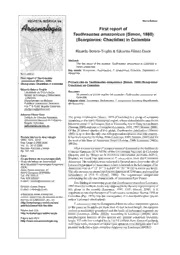
First report of Teuthraustes amazonicus (Simon, 1880) (Scorpiones: Chactidae) in Colombia PDF
Preview First report of Teuthraustes amazonicus (Simon, 1880) (Scorpiones: Chactidae) in Colombia
NOTA BREVE: First report of Teuthraustes amazonicus (Simon, 1880) (Scorpiones: Chactidae) in Colombia Ricardo Botero-Trujillo & Eduardo Flórez-Daza Abstract: The first report of the scorpion Teuthraustes amazonicus in Colombia is . herein presented Key words: Scorpiones, Teuthraustes, T. amazonicus, Colombia, Department of NOTA BREVE: Amazonas. First report of Teuthraustes amazonicus (Simon, 1880) Primera cita de Teuthraustes amazonicus (Simon, 1880) (Scorpiones: (Scorpiones: Chactidae) in Colombia Chactidae) en Colombia Ricardo Botero-Trujillo Laboratorio de Entomología, Resumen: Unidad de Ecología y Sistemática Se presenta el primer registro del escorpión Teuthraustes amazonicus en (UNESIS), Colombia Departamento de Biología, Palabras clave:Scorpiones,Teuthraustes,T. amazonicus, Colombia, Departamento Pontificia Universidad Javeriana, del Amazonas. Kra 7a # 43-82, Bogotá, Colombia [email protected]. Eduardo Flórez Daza Instituto de Ciencias Naturales, The genus Teuthraustes Simon, 1878 (Chactidae) is a group of scorpions Universidad Nacional de Colombia, occurring on the north-Neotropical region, whose representative species are Bogotá, Colombia known to occur 11 in Ecuador, five in Venezuela, two in Peru, two in Brazil [email protected]. (Sissom, 2000) and one in Colombia (Lourenço, 1995, 1997; Sissom, 2000). Of the 20 known species of this genus, Teuthraustes amazonicus (Simon, 1880) is up to date the only one with populations in more than one country. Revista Ibérica de Aracnología It has been reported for Pebas, Peru (Lourenço, 1995; Sissom, 2000) and for ISSN: 1576 - 9518. the west of the State of Amazonas, Brazil (Sissom, 2000; Lourenço, 2002a, Dep. Legal: Z-2656-2000. 2002b). Vol.13, 30-VI-2006 Sección: Artículos y Notas. After a recent revision of scorpion material deposited at the Instituto de Pp: 187-188 Ciencias Naturales (ICN-MHN) of the Universidad Nacional de Colombia (Bogota) and the Museo de la Pontificia Universidad Javeriana (MPUJ, Edita: Grupo Ibérico de Aracnología (GIA) Bogota), we found four specimens of T. amazonicus from the Colombian Grupo de trabajo en Aracnología Amazonia. The scorpions were collected in forested areas close to the city of de la Sociedad Entomológica Aragonesa Leticia (Department of Amazonas), which is located on the left margin of the (SEA) Amazonas river at 4º 12’ 55’’ S and 69º 56’ 26’’ W (82 m above sea level). Avda. Radio Juventud, 37 The city presents an annual median precipitation of 3248 mm, and a median 50012 Zaragoza (ESPAÑA) temperature of 25.8 ºC (IGAC, 1996). The vegetational components Tef. 976 324415 Fax. 976 535697 surrounding the city are characteristic of Amazonian Rain Forest. C-elect.: [email protected] This finding is interesting given that Teuthraustes guerdouxi Lourenço, Director: Carles Ribera 1995 from the northern Andes was supposed to be the only representative of C-elect.: [email protected] this genus in the country (Lourenço, 1995, 1997; Sissom, 2000). It is important to note that the report of Teuthraustes carmelinae Scorza, 1954 in Información sobre suscripción, índices, resúmenes de artículos on line, Colombia (Paz, 1978) was the consequence of a misidentification (junior normas de publicación, etc., en: author’s personal observation). http://entomologia.rediris.es/sea/ T. amazonicus may be distinguished from the other Amazonian species publicaciones/ria/index.htm of the genus as its adults are more than 45 mm in total length, the carapace Página web GIA: surface is moderately granulated and the keels of metasomal segments are http://entomologia.rediris.es/gia feeble (Lourenço, 2002a, 2002b). According to Lourenço (2002b), other morphological features of this species are: general coloration brownish, Página web SEA: http://www.sea-entomologia.org tergite VII with four vestigial keels, I to VI without them, femur of pedipalp with three keels, two pairs of lateral eyes, spiracles oval elongate, and 5 to 9 pectinal teeth (for a more complete diagnosis see Lourenço [2002b]). 188 R. Botero-Trujillo & E. Flórez-Daza Although the material was not compared with any individual from Brazil or Peru, the known distribution of this species in Brazil supports its presence in the city of Leticia. This is, taking into account that in this country the species is known from the area of Tabatinga (Lourenço, 2002b), locality that is adjacent to Leticia in the frontier between the two countries. With the new locality for T. amazonicus, the number of countries where this species occurs is herein elevated to three (Fig. 1). Acknowledgements MATERIAL EXAMINED: ICN-610, Leticia, km 20 way The authors are grateful to Camilo Mattoni (American Museum Tarapaca, 100m, 2-XI-2002, (cid:386); ICN-454, Leticia, km of Natural History, New York), Wilson R. Lourenço (Museum National d’Histoire Naturelle, Paris) and the anonymous 11 way Tarapaca, 100m, 8-XI-2001, (cid:387); ICN-455, referees for their valuable suggestions to the manuscript. To Leticia, km 18 way Tarapaca, 100m, 20-XI-2001, (cid:386); Luis G. Pérez (MPUJ, Bogota) for his assistance in the figure MPUJ-SCO-032, Leticia, Indigenous Community elaboration Monifue Amena, Chagra, 70m, X-2003, juvenile (cid:386). Fig 1: Known distribution of Teuthraustes amazonicus. Previous records in Peru and Brazil ((cid:374)); New report for Leticia, Colombia ((cid:376)) Cited References IGAC. 1996. Diccionario Geográfico de Colombia. Third Pensoft Publishers. Sofia-Moscow. 590 pp. edition. Instituto Geográfico Agustín Codazzi. Colombia. LOURENÇO,W.R. 2002b. Scorpions of Brazil. Les Éditions de LOURENÇO,W.R. 1995. Considérations sur la biogéographie l’If. Paris. des espèces appartenant au genre Teuthraustes Simon, PAZ,N. 1978. Introducción a la aracnofauna de Antioquia. 1878 (Chelicerata, Scorpiones, Chactidae). Revue Actualidades Biológicas,7(23): 2-13. Arachnologique,10(11): 201-206. SISSOM, W. D. 2000. Family Chactidae. Pp. 287-322. In: LOURENÇO,W.R. 1997. Synopsis de la faune de scorpions de Catalog of the Scorpions of the World (1758-1998). V. Colombie, avec des considérations sur la systématique et Fet, W. D. Sissom, G. Lowe & M. E. Braunwalder (eds.). la biogéographie des espèces. Revue Suisse de Zoologie, The New York Entomological Society. New York. 690 104(1): 61-94. pp. LOURENÇO, W. R. 2002a. Scorpiones. Pp. 399-438. In: Amazonian Arachnida and Myriapoda. J. Adis (ed.).
